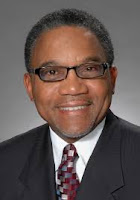
|
By Kathy Wray Coleman, editor-in-chief, Cleveland Urban News. Com and the Cleveland Urban News.Com Blog, Ohio's Most Read Online Black Newspaper and Newspaper Blog. Tel: 216-659-0473. Email: editor@clevelandurbannews.com. Coleman is a 23-year political, legal and investigative journalist who trained for 17 years, and under six different editors, at the Call and Post Newspaper in Cleveland, Ohio. (www.clevelandurbannews.com) / (www.kathywraycolemanonlinenewsblog.com). CLICK HERE TO GO TO KATHY WRAY COLEMAN AT GOOGLE PLUS WHERE SHE HAS SOME 2.5 MILLION INTERNET VIEWS alone. |
CLEVELAND URBAN NEWS.COM-Cleveland Ohio-The Cleveland branch NAACP, on Wednesday, held a press conference led by its local president Michael Nelson Sr. (pictured) and outlined the demands from the Civil Rights organization for the City of Cleveland, Mayor Frank Jackson and Cuyahoga County Prosecutor Tim McGinty relative to a grand jury decision announced Monday that the two White Cleveland cops involved in the shooting death last year of 12-year-old Tamir Rice will not face criminal charges. (Editor's note: Nationwide and Cleveland protests continue as racial unrest mounts regarding the deadly shooting).
The Cleveland NAACP demands are as follows:
• The release of transcripts from the grand jury.
• The removal of Timothy McGinty as prosecutor for Cuyahoga County, and in the event that that is not forthcoming, the defeat of McGinty at the polls to bring an end to his reign of bias and failure to protect the rights of victims.
• The demand for a re-negotiation of the union contract between the City of Cleveland and the Cleveland Police Patrolmen's Association and other city police unions
• The demand that the city identify the areas of the union contract that are in conflict with the consent decree and that have contributed to the police department’s pattern and practice of excessive use of force, and that the city address the arbitration process under the union contracts that permits arbitrators to arbitrarily override management decisions, including police firings
Last December the U.S. Department of Justice (DOJ), an arm of the federal government now led by U.S. Attorney General Loretta Lynch, the nation's first Black female attorney general, issued findings of systemic problems in the Cleveland Police Department, including illegal excessive force killings, and cruel and unusual punishment against the mentally ill.
An agreed upon court-monitored consent decree for police reforms between the city and the federal government was reached in June.
The NAACP has called for the DOJ to deepen its probe and for the collective bargaining agreements between the city of Cleveland and the Cleveland Police Patrolmen's Association and other police unions to be re-negotiated in cooperation with the consent decree.
A longtime Cleveland defense attorney who won the local NAACP presidency in October, Nelson said that the request for the release of the grand jury transcripts, which must be made before a judge and not McGinty, who lacks such authority, is proper and under the grounds of great public general interest in the Rice case.
“You had a prosecutor who was actually engaged well beyond the process," said Nelson of McGinty who is accused of handpicking experts to taint the grand jury process in favor of police. " Instead of presenting the evidence and allowing the grand jury to make a decision, he makes a recommendation for no indictment. How did he get to that?”
Nelson said that if Tamir, who was Black, were an adult and actually had a firearm, he would have been protected by Ohio’s open carry laws.
Rice was gunned down on November 22, 2014 in less than two seconds when police officers Timothy Loehmann, a rookie who pulled the trigger, and Frank Garmback, pulled up at a public park and recreation center on the city's west side where the kid was toting a toy gun, and following a foiled 9-1-1 call to police dispatchers.
Loehmann and Garmback, who both took the fifth before the grand jury and would not testify, have been reassigned to restrictive police duty pending the outcome of the disciplinary process.
| < Prev | Next > |
|---|








